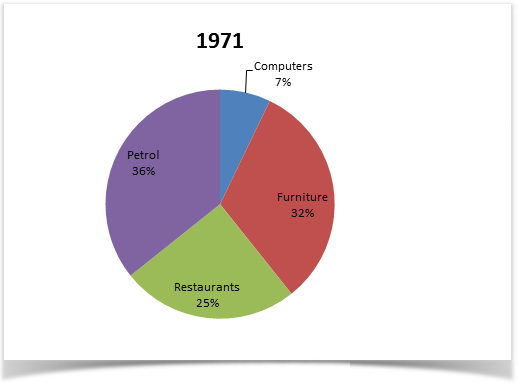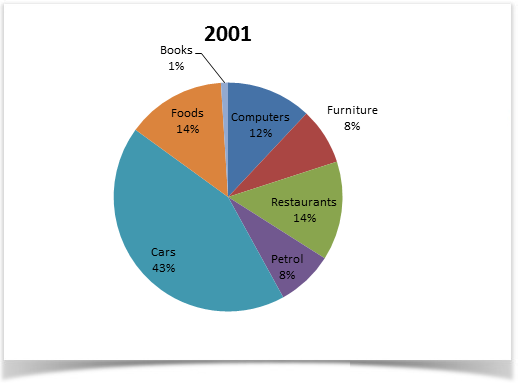» You should spend about 20 minutes on this task.
The graphs show changes in spending habits of people in the UK between 1971 and 2001.
Write a report to a university lecturer describing the data.
» Write at least 150 words.


Sample Answer 1:
The pie charts illustrate the changes in household spending in the UK between 1971 and 2001. It is clear that the cost of petrol made up the largest proportion of the household spending in 1971 while expenditure on cars was the greatest share of the household spending in 2001.
British spent more than one-third of their money on petrol and almost a third to purchase furniture followed by money spent in restaurants, which was precisely a quarter. The least proportion of expenditure was for computers, which accounted for 7% of total expenses by Brits in 1971.
After 30 years, British citizens spent significantly less portion to buy petrol, furniture and restaurant meals – 8%, 8%, 14% respectively. In comparison to 1971, they spent nearly double on computers. The largest proportion of household spending was made on owing cars with more than 40% total expenses. The proportion of expenditure on food was 14%. Finally, for books, it was considerably small, only one percent of total costs in 2001.
[ Written by – Iraj ]
Sample Answer 2:
The provided pie charts give information on the spending habits of UK citizens in 1971 and 2001. As is observed from the charts, the expenditure on petrol & furniture reduced significantly while the amount spent on computers increased in the UK.
In 1971, British spent 36% on petrol which was the highest percentage among the given expense categories. Their expense on Furniture was second largest (32%) while they spent one quarter on restaurant meals. The least portion was spent by them for purchasing computers, which was only 7% in this year.
After 30 years, the expense to buy petrol and furniture reduced to 8% each, significantly lower than the percentages spent in 1971. But the expense made on computers increased by 5% in 2001. People spent 1% on books in this year. The expenses for restaurant decreased to 14% compared to the 25% in 1971. The highest amount spent in 2001 by the British was on cars and that consisted almost half of the total expenses in this year.
Sample Answer 3:
The pie charts provide a statistical comparison on the difference in spending by the UK residents in 1971 and 2001.
According to the illustration, the largest proportion of spending by Brits in 1971 was on petrol, 36% o be exact, which was 4 times higher than their cost in this item in 2001. The second highest spending in 1971 was on furniture, which constituted 32% of all costs. Expenses on food remained approximately on the same level with one difference – in 1971, people preferred more to go to restaurants, while in 2001 they split up those to 14% to buy food for themselves and 14% to eat outside. It is interesting to note that almost half (43%) of the budget of the UK citizens was invested in cars in 2001. Costs on computers increased from 7% in 1971 to 12 % in 2001.
Overall, the spending habits of the British significantly changed during the period. Whereas in 1971 people spend most of the money for furniture and fuel, cars and computers have become the main investment in 2001.
[ Written by – Ann Alex ]
Sample Answer 4:
The pie charts compare the proportion of expenditure of British citizens in different categories in 1971 with that of 2001. Overall, fuel, furniture and outside meals drained the highest proportion of British expenditure in 1971, but personal cars cost them the highest after three decades.
According to the illustration, Brits used one-quarter of their total expenses to dine in different eateries while almost one-third to own furniture. Petrol cost them the highest, 36% to be precise, and those citizens spent only 7% to buy computers.
After 30 years, 43% of their expenses went on owing cars. Their cost ratio on furniture became one-fourth and they spend slightly less than half on restaurant meals as they did three decades earlier. How much they spent on home cooked food in 1971 was not provided but it was 14% in 2001. They spend 5% more for purchasing computers and petrol costs only 8% in 2001. The least percentage of spending was made to buy books, for which no data was given in the early chart.
